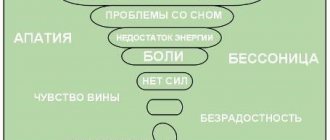Living example
To make it clearer what we are talking about, I will immediately present a life picture. A typical case from my own practice. For several years, the patient, a young woman, complained to doctors of various specialties in our clinic. To the gastroenterologist she complained of pain in the pit of the stomach, heartburn, and abdominal cramps. An objective examination—FGS, X-ray, ultrasound—could not identify the disease. After this, as if by magic, the digestive problems disappeared, giving way to cardiological complaints. The patient visited a cardiologist, reporting pain in the left side of the chest, palpitations and surges in blood pressure. Since the ECG and ultrasound of the heart also showed normal results, the doctor began to doubt the origin of the complaints. Cardiologists and therapists are well aware of exactly where pain in angina pectoris is usually localized and what symptoms it is accompanied by. The cardiologist suggested that the lady visit a psychiatrist, but she indignantly refused. Heart problems (apparently from “righteous” anger) disappeared, and the patient attacked the gynecologists. Another leisurely process of examination and treatment began, and (surprise, surprise!) - just as unsuccessful as the previous ones. And then a urologist, an endocrinologist, a neurologist fell victim to a “complicated” patient... And the “moment of truth” came when each of them uttered the mantra: “Girl, you should see a psychiatrist!..”
Masked depression (or larvated, somatized depression - from the Latin larva, that is, “larva”, “embryo”) is a type of depressive state in which low mood is masked by somatic and vegetative symptoms predominant in the clinical picture, as well as psychopathological signs of another, not of a depressive nature (obsessiveness, drug addiction attacks). In this case, the actual affective depressive symptoms are relegated to the background, which creates serious difficulties in diagnosing larval depression.
Bleikher V. M., Kruk I. V. Explanatory dictionary of psychiatric terms. Voronezh: NPO "MODEK", 1995
And so the patient appeared in my office to bring down the accumulated health complaints on my head, and at the same time on the careless physicians, helpless in the face of the sufferer’s ailments. Her anger was righteous, and her determination to restore her reputation was great... Well, in the end, a banal thing turned out to be true. The patient's husband drank. And he cheated. He ignored his wife in every possible way. And at work there was no career growth, but only a picky boss and “thieves” colleagues. It became obvious that the castles in the air built in youth were dissolving into thin air, while youth was being eaten up by work, everyday life and empty hassle. And my mood began to decline... Anxiety, tension, insomnia, fatigue, and irritability appeared. And then the pain came...
The patient was helped. A month later she confidently began to recover. But the most difficult thing in such a situation is not eliminating the manifestations of the disease, but fighting their causes, the fundamental principle that launched the process of the disease. And doctors, as a rule, are unable to help with this. A person must determine his own life priorities and change taking into account the circumstances of his destiny.
From 1/3 to 2/3 of all patients seen by general practitioners, as well as by specialists, suffer from depression, masked hypochondriacal symptoms or complaints of physical malaise. For these disorders, women are 2–3 times more likely than men to seek help from a primary care physician.
(Smulevich A.V., Syrkin A.L., Rapoport S.I. et al. Organ neuroses as a psychosomatic problem // Journal of neurology and psychiatry. 2000. No. 12. P. 4–12).
In a situation of larval depression, classic symptoms and depressive manifestations (low emotional background, apathy, withdrawal from contacts with the outside world) may be insignificant or even completely absent. Although this is a controversial issue, in some cases associated with the doctor’s insufficient attention to the patient’s complaints or behavior. The patient is often unaware of the depressive disorder. He may be convinced that he has some rare and difficult to diagnose disease of the internal organs, or he draws the attention of his and the doctors to some neurotic symptoms, biological rhythm disorders, insomnia. In my practice, for example, the bulk of such patients are delivered by colleagues - cardiologists and gastroenterologists, and the neurologist and therapists are not far behind. A simple fact is obvious: the more experienced and qualified the internist, the more often he suspects that fate has brought him together with a psychiatrist’s client. And, as experience shows, attentive doctors rarely make mistakes!
Definition and types
Masked depression is a type of mental disorder that is subdepressive in nature. This condition is often difficult to detect, since it is often disguised as manifestations of addiction or a certain disease, and bad mood and depression are not particularly noticeable. Knowledge about its main features, as well as what symptoms characterize it, helps to identify this disorder in a timely manner.
This type of depression can occur in two forms.
- Psychosomatic. A person makes many complaints indicating various diseases. However, they are not enough to suggest a specific disease. For example, there may be tingling in the limbs, sensations of pain, problems in sexual life.
- Psychopathological. The person is in a depressed state. He feels excessive fatigue, increased anxiety, a feeling of loneliness does not leave him, there is no desire to communicate with other people or enjoy life, there is a feeling of inferiority.
Depending on the characteristics of the disorder and its symptoms, there are several variants of this type of depression.
- Agripnic. Characterized by sleep disturbance. It is difficult for an individual to fall asleep, sleep is intermittent and superficial. Often a person wakes up earlier than expected, but is unable to fall asleep. At the same time, he does not feel rested.
- Algic-senestopathic. A person experiences strange sensations spreading throughout his body, often accompanied by pain. There may be a concentration of pain in a certain area of the body, and migration to various organs is also possible.
- Vegetative-visceral. Manifestations are characteristic of vegetative-vascular dystonia, accompanied by unstable blood pressure, respiratory rate, and heart rate. There is also increased sweating and increased temperature. Flatulence and abdominal discomfort may occur.
- Drug addict. Develops against the background of drug addiction and alcoholism. By resorting to alcohol or drugs, a person tries to escape from a subdepressive state.
- Psychopathic. Occurs in adolescence, and can also occur in adolescence. The teenager is often in no mood, is lazy to do anything, perceives demands and requests very negatively, and almost never experiences joy. But parents should know that such manifestations do not always indicate that the teenager has masked depression of a neurotic nature. This behavior may be an age-related feature of the psyche.
- Asexual. A person loses interest in representatives of the opposite sex, and there are no positive emotions from communication. In men it manifests itself as impotence, in women - frigidity.
It is important to know that in special cases different types of masked depression can be combined. This phenomenon greatly complicates the identification of the root cause of the disease.
Masks of depressive disorder
Masked depression is divided into masks (types) depending on which symptoms predominate.
- Psychopathological disorders: obsessive-compulsive, anxiety-phobic, hypochondriacal, neurasthenic.
- Biological clock disorders: nightmares, insomnia, hypersomnia;
- Masks in the form of algia: pain in the abdomen, heart, spine, head, joints, pseudorheumatic arthralgia, neuralgia.
- Endocrine and somatized autonomic disorders: VSD syndrome, itchy skin, bulimia or anorexia, neurodermatitis, disorder of internal organs of a functional nature, in particular, irritable bowel and stomach syndrome, cardioneurosis.
- Behavioral disorders: the formation of addictions, in particular drug addiction and alcoholism, hysteria, antisocial behavior.
From the editor: Causes and classification of cerebral vascular malformations
Why are “saboteurs” dangerous?
In these states, the manifestations of depression are hidden behind a “façade” of various somatovegetative symptoms, so the doctor initially gets the impression that there is a somatic disease. Patients turn not to a psychiatrist, but to other specialists, are examined for a long time without success and treated in hospitals, where sometimes even serious interventions are undertaken. At the same time, doctors do not always pay attention to the low mood of patients, their statements about the severity of their physical condition and the failure of therapy, and in some cases about their reluctance to live. These complaints are often associated with the severity of the underlying disease. At the same time, the danger of suicide in masked depression, as in classic depression, is great.
Such patients are reluctant to go to psychiatrists even when there is a suspicion of a mental disorder. The period of treatment by various specialists can stretch for a long time, sometimes reaching 5–8 years, and the severity of depression usually increases. Suicidal attempts in general somatic hospitals are not uncommon, and a study of the medical histories of such suicides shows the presence of unrecognized, delayed depression. Medical staff and internists are often not prepared for such a turn of events, unlike psychiatric workers who are “always on guard.”
In some cases, psychiatrists cannot exclude the presence of a somatic illness, or they associate a depressed mood with the difficulty of diagnosing and treating a supposed “internal” illness.
Reconnaissance in force
Patients with masked depression are encountered in the practice of doctors of many specialties. Pediatricians may be contacted with complaints of headaches and abdominal pain. At the same time, children sometimes complain of feeling tired, poor sleep, loss of the ability to enjoy life, deterioration in academic performance, and difficulties in making decisions (if we are talking about older children). A diagnosis of a somatic disease that could explain such complaints is usually not possible to make.
Neurologists and neurosurgeons see patients suffering from headaches, which sometimes raise suspicion of a brain tumor, as well as complaints of pain in the face, spine, and limbs.
Patients turn to therapists with complaints of cardiac dysfunction with the appearance of pain, increased or rapid heartbeat, and feelings of tightness in the chest, and they may experience changes in the ECG that disappear after treatment with antidepressants. In the practice of therapists, “masks” may occur in the form of attacks of bronchial asthma, colitis, gastritis, and peptic ulcers.
Patients turn to surgeons with complaints of pain and discomfort in the abdominal cavity. In some cases, the picture of an “acute abdomen” is almost completely imitated, which can lead to unjustified surgical interventions.
Patients come to gynecologists with various kinds of dysmenorrhea and pain in the appendage area, and to dermatologists with eczema and dermatoses.
Patients with larvic depression, whom otorhinolaryngologists meet, complain of pain in the ears or sensations of “stuffing”, difficulty swallowing, hoarseness or sensations of a “lump in the throat”, vague pain in the mouth and pharynx.
Patients with a feeling of blurred vision and the appearance of blepharospasm are referred to ophthalmologists. Dentists see patients with larvic depression, suffering from neuralgic pain, which can lead to tooth extraction, after which the pain does not disappear.
Psychiatrists should suspect larval depression from all types of drug addictions, periodically occurring neurotic disorders, and various types of behavioral disorders in childhood and adolescence.
The problem of larval depression is one of the most complex and theoretically and practically relevant issues of modern psychiatry.
Larviroral, masked, hidden or, as they are often called nowadays, somatized depression include conditions in which the manifestations of depression are hidden behind a “façade” of various somatovegetative symptoms. Timely diagnosis of these conditions is significantly difficult, since the impression of the presence of a somatic disease is often created. Patients usually turn not to a psychiatrist, but to other specialists, are unsuccessfully examined for a long time and treated in appropriate institutions, where various types of serious interventions are sometimes undertaken. At the same time, general practitioners do not pay due attention to the low mood of patients, their statements about the severity of somatic loss and the failure of therapy, and in some cases about their reluctance to live; Moreover, doctors usually associate these complaints with the severity of the underlying disease. At the same time, the suicidal danger of such depression is very high. Difficulties in diagnosis are due to the fact that the period of treatment by various specialists can stretch for a long time, sometimes reaching 5-8 years, and the intensity of depression during this time, as a rule, increases significantly. As Lopez Ibor (1972, 1973) and Kielholz (1982) noted, currently suicide attempts are made in non-psychiatric hospitals much more often than in psychiatric ones. Subsequent study of case histories shows that the patients had severe depression. Their untimely diagnosis is primarily due to the fact that doctors of various specialties are not sufficiently familiar with the clinic of larval depression. In this regard, there was a need to include issues of clinical psychiatry (including clinics for generalized depression) in the advanced training course for internists. Difficulties in diagnosing larval depression are also associated with the fact that patients usually do not complain of depressed mood, but complain of various types of somatic manifestations. They are reluctant to turn to psychiatrists even when there is an assumption that they have a mental illness. In some cases, psychiatrists cannot exclude the presence of a somatic disease or are inclined to give a purely psychological explanation to the depressed mood of patients, linking it with the difficulty of diagnosing and treating the alleged somatic disease.
Larval depressive states were described back in the last century. Falret (1878, 1879) considered them a milder form of circular psychosis. Kahlbaum (1889) classified these rudimentary forms of circular psychosis as cyclothymia. Pinel and Esquirol indicated somatic symptoms in patients with mania and melancholia. Y.A. Anfimov (1899) called larval depressive states periodic laziness. S.V. Kannabikh (1914) classified these conditions as cyclothymia, designating them as “equivalents of a depressive attack.” Therapist D.D. Pletnev (1927), describing patients with periodically occurring obesity, pointed out that obesity is not a concomitant, but the main manifestation of depression. He designated these conditions as somatic cyclothymia. In the literature you can find other names for larval depression: cyclosomia (E.E. Krasnushkin, 1960), affective-depressive equivalent (Yu.V. Kannabikh, 1914), somatic equivalent (T.A. Nevzorova, 1962,1965), affective equivalent, depression without depression, thymopathic equivalent, psychovegetative syndrome, etc.
In recent years, the number of studies devoted to the study of larval depression has increased significantly. There is a tendency to expand the range of disorders described as so-called “facade” symptoms. In addition to somatovegetative manifestations, they also include various drive disorders and behavioral anomalies (V.F. Desyatnikov, 1965, 1981, etc.). Kielholz (1972,1973) only limits the range of these depressions to conditions where somatic symptoms come to the fore. A.K. Anufriev (1978) also adheres to a similar point of view.
Manic depressions are extremely polymorphic, which refers both to the manifestations of the somatovegetative “facade” and to the affective radical, expressed by subdepressions of various structures. As somatovegetative manifestations, they may experience sleep disorders, changes in body weight, unpleasant sensations in the head, headaches, migraines, Meniere-like syndrome, neuralgia and myositis, lumbago, brachialgia, femoralgia, trigeminal pain, a feeling of numbness and coldness in some part body, pain or discomfort in the heart area, various arrhythmias, changes in blood pressure with the development in some cases of vascular crises, as well as various visual disturbances - flickering before the eyes, luminous circles, colored sparks, transient nystagmus or diplopia, blepharospasm, deterioration of vision that cannot be easily corrected, and various types of allergic manifestations, including dermatitis, eczema and even, according to some descriptions, attacks of bronchial asthma. Morning and daytime vomiting, akathisia, dry mouth, noise and ringing in the ears, various pains and discomfort in the abdominal cavity, colitis and gastritis, and impotence are also described as so-called “facade” symptoms. As this rather extensive, but far from complete (exhaustive) listing shows, the “masks” of larval depression can be infinitely varied.
The variety of symptoms indicates that patients with severe depressive states can be encountered in the practice of doctors of many specialties (Peters, Halzel 1971). Patients may contact pediatricians with complaints of headaches and abdominal pain. At the same time, children sometimes complain of feeling tired, poor sleep, loss of the ability to enjoy life, deterioration in academic performance, and difficulties in making decisions (if we are talking about older children). A diagnosis of a somatic disease that could explain such complaints is usually not possible to make. Neurologists and neurosurgeons see patients suffering from headaches, which sometimes raise suspicion of a brain tumor, as well as complaints of pain in the face, spine, and limbs. Patients turn to therapists with complaints of cardiac dysfunction with the appearance of pain, increased heartbeat, tachycardia, and a feeling of tightness in the chest, and they may experience changes in the ECG that disappear after treatment with antidepressants. In the practice of therapists, “masks” may occur in the form of attacks of bronchial asthma, colitis, and pseudothyrotoxic conditions. Patients may contact surgeons with complaints of pain and unpleasant sensations in the abdominal cavity. In some cases, the picture of an “acute abdomen” is almost completely imitated, which can lead to unjustified surgical interventions. Pseudothyrotoxic conditions, sometimes with a slight enlargement of the thyroid gland and an increase in basal metabolism, are encountered in the practice of surgeons and can also serve as a reason for surgical interventions. Patients with various types of dysmenorrhea and pain in the appendage area turn to gynecologists, and dermatologists with eczema and dermatoses. Patients with larval depression who turn to otorhinolaryngologists complain of pain in the ears or sensations of “stuffing,” difficulty swallowing, hoarseness or sensations of a “lump in the throat,” vague neuralgia in the mouth and pharynx. Patients with a feeling of blurred vision and the appearance of blepharospasm are referred to ophthalmologists. Dentists see patients with larvic depression, suffering from neuralgic pain, which can lead to tooth extraction, after which the pain does not disappear.
This list, which is far from complete, clearly demonstrates both the diversity of depressive “masks” and the difficulties that arise in diagnosing them.
For psychiatrists, it is important that a number of authors indicate that suspicion of larval depression should be caused by all types of drug addictions, periodically occurring neurotic disorders, and various types of behavioral disorders in childhood and adolescence (Fonseca, 1963, etc.).
The pronounced polymorphism of larval depressions extremely complicates attempts to create their classification. In the domestic literature, the works of T.A. Nevzorova (1962, 1964, 1965), T.A. are devoted to the classification of larval depressions. Khvilivitsky (1957, 1965), A.K. Anufriev (1968), V.F. Desyatnikov (1965, 1981), T.A. Nevzorova and Yu.Z. Drobizhev (1962). However, to date, there is no unified classification of larval depression, which is largely due to the heterogeneity of the approach to its creation.
An important feature of larval depression, which usually helps in making a diagnosis, is that the manifestations of the somatovegetative “facade” usually do not fit completely within the framework of the disease that they imitate, and doctors of non-psychiatric specialties, as a rule, note this fact, and also pay attention to failure to treat suspected somatic suffering. Particular attention should be paid to this fact, since it usually makes one suspect the presence of larval depression.
The main difficulties in diagnosing latent depression lie primarily in detecting affective disorders themselves. A psychiatrist must be able to identify various signs of hypothymia present in the structure of the condition. You should pay attention to mild depression, inability to enjoy life, difficulties in communicating with others, desire for solitude, limited contacts, decrease in previous energy and activity, difficulty in making decisions, anxiety, “nervousness” (sometimes with a feeling of fear), an abundance of various somato-vegetative complaints that do not fit into the framework of a specific disease, disorders of vital functions - sleep disturbance (in the form of reduced duration or early awakening), decreased appetite, potency, weight loss, menstrual irregularities, as well as daily fluctuations in affect and somatovegetative disorders (worsening more often in the evening).
When studying the course of the disease, diagnostic criteria may include the frequency of occurrence of somatovegetative and mental disorders, the presence of a history of unclear somatic disorders, erased, classic depressive or manic phases, the spontaneity of the onset and disappearance of attacks of the disease, the seasonal occurrence of attacks of the disease.
When diagnosing larval depression, data on the lack of effect of somatic therapy and a positive reaction to antidepressant therapy can be of great help. Regarding the question of the nosological affiliation of larval depressions, it is worth recalling the previously published works of authors attributing these cases to periodic melancholia or cyclothymia. Currently, larval depressions are described within the framework of endogenous affective pathology. There is a point of view that these conditions can be classified as a group of neuroses (V.N. Myasishchev, 1960, 1963). A.K. Anufriev (1978) believes that Lemke's vegetative depression, Weitbrecht's endoreactive dysthymia and the early stages of Kielholz's exhaustion depression are larved depressive states. All these variants of larval depression should be classified as endogenous psychoses that occur in phases.
With cyclothymia, larval depressions more often occur within the framework of a unipolar depressive type of course. In these cases, larvated depressions can be repeated in a “cliché” type, with a certain seasonal interest. There are cases when, with cyclothymia, phases alternate in the form of larval depressions with phases that occur as ordinary subdepressive states. With a cyclothymic course, larval depressive states can also occur as part of a bipolar course, although these cases are observed somewhat less frequently.
In more severe, so-called “psychotic” variants of manic-depressive psychosis, larval depressive states can be combined with phases in which depression passes from larval subdepressions to massive vital ones with an affect of melancholy, ideas of self-blame, and suicidal thoughts.
In schizoaffective psychoses and schizophrenia, the course of the disease may combine milder paroxysmal states that occur with a picture of larval depression with attacks in the form of massive depression or affective-delusional states. A feature of the somatovegetative “facade” in these cases is a significant proportion of senestopathies, and such conditions are possible with Cotard’s nihilistic delirium (A.K. Anufriev, 1978).
As already mentioned above, a characteristic feature of larval depressions is their protracted course. Within one phase or attack, these conditions may not undergo significant dynamics, remaining at the level of larval subdepression. Quite often there is a gradual deepening of the affective radical state with the appearance of feelings of melancholy and anxiety, an affect of despair, suicidal thoughts and attempts. With an increase in the intensity of depression, in some cases it is “cleansed” from the somatovegetative “facade”, but more typical is the simultaneous increase in the intensity of somatovegetative and affective manifestations. In this case, a modification of the psychopathological structure of both the somatovegetative and affective components of the state occurs. The issues of the dynamics of larval depressions can be found in the work of A.K. Anufriev (1978); The scope of this lecture does not allow us to cover this issue in detail.
It is difficult to provide comprehensive recommendations regarding the treatment of larval depression. Typically, various combinations of antidepressants with antipsychotics, and in some cases with tranquilizers, are used. The best drug from the group of antipsychotics that can be recommended for the treatment of larval depression is teralen, but its use is currently sharply limited due to the lack or absence of the drug. The doses of the agents used and the methods of their administration should vary taking into account the characteristics of specific cases. Taking into account the tendency of larval depression to have a protracted course, measures should be taken, if possible, to overcome emerging resistance to therapy. Unfortunately, it is difficult to give definite therapeutic recommendations in this regard. When monitoring a patient with larval depression and treating them, one should take into account the possibility of a gradual or acute increase in the intensity of the depressive radical, the appearance of suicidal thoughts and raptoid states. If such conditions occur, patients should be immediately sent to the hospital.
In the vast majority of cases, patients with larvated depression are treated on an outpatient basis and, as noted above, are observed for a long time in non-psychiatric institutions. In this regard, the introduction of a full-time psychiatrist position in non-psychiatric hospitals and clinics should be recognized as an important organizational measure that can provide adequate treatment for a larger contingent of patients with chronic depression and lead to a reduction in the suicidal risk of these conditions.
Bibliography
I. Anufriev A.K. Hidden endogenous depression (messages 1,2,3) // Journal of neuropathology. and psychiatrist., 1978, No. 6,8,9. P.857, 1202, 1342.
2.Anfimov Y.A. Periodic fatigue (laziness, apathy) and periodic psychoses // 25th anniversary of the Society of Scientific Medicine and Hygiene at Kharkov University: Coll. Art. Kharkov, 1899, pp. 37-53.
3. Desyatnikov V.F. Masked depression (literature review)//Journal of neuropathology. and psychiatrist., 1975. P.760-771.
4. Desyatnikov V.F., Sorokina T.T. Hidden depression in the practice of doctors. Minsk, 1981. P.240.
5. Kannabikh Yu.V. Cyclothymia, its symptomatology and course. M., 1914"
6. Krasnushkin E.K. On some relationships between mental and somatic illnesses (selected works). M., 1960. P.427-445.
7. Lukomsky I.I. Affective insanity. M.: Medicine, 1968. P. 169.
8. Mikhailova N.M. Clinical features of affective psychoses, intermediate between MDP and paroxysmal schizophrenia // Journal, neuropathol. and psychiatrist., 1974. No. 1. pp. 106-112,
9.Myasishchev V.N. The relationship between the mental and the somatic in general and systemic neuroses // Questions of the relationship between the mental and the somatic in psychoneurology and medicine: Collection of articles. L., 1963. P.193-205.
10. Nevzorova T.A., Drobizhev Yu.Z. Somatic equivalent of circular psychosis and cyclothymia // Sov. Med., 1962, No. 12, P.45-49.
11. Papadopoulos T.F., Shakhmatova-Pavlova I.V. Manic-depressive psychosis: A guide to psychiatry, ed. A.V. Snezhnevsky. M.: Medicine, 1983. T.I. P.417-456.
12. Pletnev D.D. On the issue of somatic cyclothymia. Russian clinic, 1927. T.7. No. 36. P.496-500.
13. Severny A.A. Clinical follow-up study of schizoaffective psychosis with a favorable outcome. Author's abstract... cand. honey. Sci. M., 1980. 18 p.
14. Snezhnevsky A.V. Pathology of emotions: A guide to psychiatry / Ed. A.V. Snezhnevsky. M.: Medicine, 1983. T.1. P.22-29.
15. Tiganov A.S. Affective syndromes: Handbook of psychiatry. M.:Medicine, 1974. P.48-52.
16. Khvilivitsky T.Ya. The doctrine of manic-depressive psychosis, clinical picture and treatment of its atypical forms // Book: Questions of psychiatry in neuropathology. L., 1957. T.2. P.80-89.
17. Sternberg E.Ya. Review of foreign literature on manic-depressive psychosis and other affective psychoses // Journal. neuropathol. and psychiatrist., 1960. No. 3. P.354-368.
18. Sternberg E.Ya. Two new foreign monographs on endogenous affective psychoses // Journal. neuropathol. and a psychiatrist. 1968. No. Z. pp. 461-465.
How to recognize the enemy?
I must immediately make a reservation that there are no clear criteria for diagnosing masked depression. It helps to establish a diagnosis that somatovegetative symptoms usually do not fit completely within the framework of the disease that they mimic, and doctors of non-psychiatric specialties, as a rule, notice this, and also pay attention to the failure of treatment of the suspected somatic disease.
The most difficult thing to detect is the actual disturbed mood. The doctor must be able to identify the various signs of depression present in the clinic of such an illness.
They suggest the idea of masked depression - the frequency of appearance of somatovegetative and mental disorders, the presence of a history of unclear somatic disorders, erased, classic depressive or manic phases, the suddenness of the onset and disappearance of attacks of the disease, the seasonal occurrence of attacks of the disease - mainly in the autumn-spring period, which is typical and other classic types of depression. Data on the lack of effect from somatic therapy and a positive reaction to treatment with antidepressants can be of great help in diagnosis.
How to prevent hidden depression?
Finally, we will give you some tips on how not to bring yourself to a state of masked depression:
Prevent masked depression: useful tips
Maintain a schedule of work and rest, as well as sleep and rest. It's a trite piece of advice, but the production of many hormones occurs during sleep, and therefore there is no need to treat it carelessly
The latest scientific research shows the importance of a balance of rest and an active, active state, so take this seriously. The active state includes not only work, but also reading, watching TV shows, etc.
- anything that leads to fatigue of the nervous system.
Take a close look at your work schedule. Workaholism not only disrupts work and rest patterns, but also entails changes in physical activity, constant psycho-emotional stress, suppression of body signals about fatigue, etc. If you see signs of workaholism in yourself (which is very unlikely, for workaholics, work is life) or with your loved ones - make every effort to reduce the load.
Be more attentive to your emotions, do not suppress them inside yourself. , yoga. In the process of practicing yoga, you will be able to live through your unlived emotions and remove physiological blocks from emotions, and in the process of playing sports, ensure the production of endorphins and again feel the joy of life and pleasure.
If emotions are “pressing”, do not hesitate to go to the doctor and support similar decisions with your loved ones. Sometimes, to improve your condition, you need to talk out or just see a person who is ready to listen and accept you, and sometimes you need medical help in the form of antidepressants, nootropics, etc. In any case, the decision on treatment tactics should be made by a psychotherapist. WHO recommends that mild forms of depression be treated with using group or individual therapy, but in any case you need to see a doctor. Often the decision to see a doctor is the most difficult.
From the editor: The use of mnemonics for memory development
Particular attention should be paid to people at risk due to endocrine diseases or hormonal changes. Depression can not only be hidden, it can also occur without obvious traumatic events. If you or your loved ones have signs of hidden depression, hysteria, or an overt depressive state due to pregnancy and childbirth, diabetes, thyroid diseases, etc., help for them and yourself - consult a doctor.
Be attentive to your health and the health of those close to you, engage in prevention and prevention of long-term stressful conditions, and with a high degree of probability you will not need the appointments and recommendations of mental health specialists.
Thank you for reading this article. We welcome your questions and comments.
Masked depression: symptoms, prognosis and treatment
Typically a protracted course with slight fluctuations in low mood within one attack. Often there is a gradual deepening of the depressive state with the appearance of feelings of melancholy and anxiety, despair, suicidal thoughts and attempts. As the severity of depression increases, in some cases it is “cleansed” from the somatovegetative “façade”, but more typical is the simultaneous increase in somatovegetative and emotional manifestations.
Typically, patients begin to be treated on an outpatient basis, using various combinations of antidepressants with antipsychotics, and in some cases with tranquilizers. Doses and methods of their administration differ depending on the characteristics of specific cases. Given the propensity of masked depression to be protracted, measures must be taken to overcome emerging resistance to therapy. If the depth of depression increases or suicidal thoughts appear, patients should be immediately sent to a hospital.
The introduction of a full-time psychiatrist position in non-psychiatric hospitals and clinics will provide adequate treatment for a larger number of patients with latent depression and will lead to a reduction in the risk of suicide in these conditions. And, of course, it is necessary to include issues of clinical psychiatry (including clinical depression clinics) in the advanced training course for internists.










